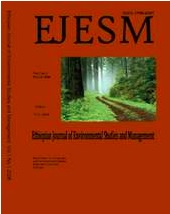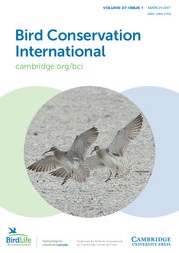|
Alumni Publications
 Agaldo, J. A., Gwom, T. G., & Apeverga, P. T. (2016). An assessment of present threats and associated conservation implication to the Oban division Forest Cross river national park; Nigeria’s biodiversity hotspot. Ethiopian Journal of Environmental Studies and Management, 9(2): 938-950. Agaldo, J. A., Gwom, T. G., & Apeverga, P. T. (2016). An assessment of present threats and associated conservation implication to the Oban division Forest Cross river national park; Nigeria’s biodiversity hotspot. Ethiopian Journal of Environmental Studies and Management, 9(2): 938-950.
In recent years the Oban Division of Cross River National Park has received little research attention on its conservation status and species composition. It is known to be one of the most biodiversity-rich protected areas in West Africa. Hence current knowledge of its status is necessary for making informed management decisions for the continuous and improved protection of the area. This study sought to provide recent information on the conservation status of the area and its species. We used reconnaissance survey to assess present threats associated with the area and related this to encounter rate of faunal species in the area. Thirteen potential present threats to the area and its species were recognised. The encounter rate of primate species was 0.373 per km2, while mammals and large birds had an encounter rate of 1.148 km2 and 1.234 km2 respectively. Low encounter rates of these faunal groups suggests their population is declining in the area. Hence protection measures need to be improved in this important remaining forest in Nigeria to protect its species from continuous decline and its integrity as Nigeria’s biodiversity hotspot.
 Cáceres, A., Melo, M., Barlow, J., de Lima, R.F., & Mills, M.S.L. (2017) Drivers of bird diversity in an understudied African centre of endemism: The Angolan Central Escarpment Forest. Bird Conservation International, 1-13. doi:10.1017/S0959270917000119. Cáceres, A., Melo, M., Barlow, J., de Lima, R.F., & Mills, M.S.L. (2017) Drivers of bird diversity in an understudied African centre of endemism: The Angolan Central Escarpment Forest. Bird Conservation International, 1-13. doi:10.1017/S0959270917000119.
Natural habitats are being rapidly lost due to human activities. It is therefore vital to understand how these activities influence biodiversity so that suitable guidelines can be established for conservation. This is particularly important in understudied, high biodiversity, areas such as the Angolan Escarpment. Here we examine which habitat characteristics drive bird diversity and endemic species presence at Kumbira Forest, a key site in the Central Escarpment Forest. Bird diversity was sampled by 10 min bird point counts, whereas habitat characteristics were measured by a combination of ground-based vegetation surveys and remotely sensed data modelling of Landsat images. GLM, multi-model inference and model averaging were used to determine the most important variables driving species richness and the presence of endemics. The remote sensing variables performed poorly in predicting presence of red-crested turaco Tauraco erythrolophus and Gabela bushshrike Laniarius amboimensis but they contributed significantly to explain species richness and Gabela akalat Sheppardia gabela presence, both of which were associated with greater canopy cover. Liana density and elevation were also important explanatory variables in certain cases. Conservation actions at Kumbira should focus on increasing canopy cover and maintaining forest integrity (as measured by liana density), as these actions are likely to have the most positive outcomes for the avifauna.
 Lwin, N., Linkie, M., Harihar, A., Aung, S., Lin, A., & Momberg, F. (2016) Initiating conservation of a newly discovered population of the Endangered hog deer Axis porcinus in Myanmar. Oryx, 1-8. doi:10.1017/S0030605316000727 Lwin, N., Linkie, M., Harihar, A., Aung, S., Lin, A., & Momberg, F. (2016) Initiating conservation of a newly discovered population of the Endangered hog deer Axis porcinus in Myanmar. Oryx, 1-8. doi:10.1017/S0030605316000727
The unprecedented political and economic reforms taking place in Myanmar offer new opportunities for biodiversity conservation. They also bring new challenges in the form of rapidly growing extractive industry and agriculture sectors that have been weakly regulated and are often unsustainable. The Endangered hog deer Axis porcinus epitomises many of these conservation challenges, and those facing most deer species in the Indo–Burma hotspot. The hog deer has disappeared from large parts of its range as a result of overhunting and intense conversion of its floodplain grassland habitat for agriculture. We report on a population of hog deer that was discovered in the Indawgyi landscape in central Myanmar in 2012. We conducted the first rigorous assessment of a hog deer population in Myanmar using an occupancy sampling protocol, tested the protocol's robustness using a power analysis, and present the results to guide management intervention. The results from our study site revealed widespread occurrence of the species, with high precision…
See all alumni publications
|